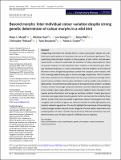Por favor, use este identificador para citar o enlazar a este item:
http://hdl.handle.net/10261/303289COMPARTIR / EXPORTAR:
 SHARE SHARE
 CORE
BASE CORE
BASE
|
|
| Visualizar otros formatos: MARC | Dublin Core | RDF | ORE | MODS | METS | DIDL | DATACITE | |

| Título: | Beyond morphs: Inter-individual colour variation despite strong genetic determinism of colour morphs in a wild bird |
Autor: | Mould, Maya C.; Huet, Michèle; Senegas, Lou; Milá, Borja CSIC ORCID ; Thébaud, Christophe; Bourgeois, Yann; Chaine, Alexis S. | Palabras clave: | Colour polymorphism Colour quantification Genetic of coloration Morph classification Zosterops borbonicus |
Fecha de publicación: | ene-2023 | Editor: | John Wiley & Sons | Citación: | Journal of Evolutionary Biology 36(1): 82.94 (2023) | Resumen: | Categorizing individuals into discrete forms in colour polymorphic species can overlook more subtle patterns in coloration that can be of functional significance. Thus, quantifying inter-individual variation in these species at both within- and betweenmorph levels is critical to understand the evolution of colour polymorphisms. Here we present analyses of inter-individual colour variation in the Reunion grey whiteeye (Zosterops borbonicus), a colour polymorphic wild bird endemic to the island of Reunion in which all highland populations contain two sympatric colour morphs, with birds showing predominantly grey or brown plumage, respectively. We first quantified colour variation across multiple body areas by using a continuous plumage colour score to assess variation in brown-grey coloration as well as smaller scale variation in light patches. To examine the possible causes of among-individual variation, we tested if colour variation in plumage component elements could be explained by genotypes at two markers near a major-effect locus previously related to back coloration in this species, and by other factors such as age, sex and body condition. Overall, grey-brown coloration was largely determined by genetic factors and was best described by three distinct clusters that were associated to genotypic classes (homozygotes and heterozygote), with no effect of age or sex, whereas variation in smaller light patches was primarily related to age and sex. Our results highlight the importance of characterizing subtle plumage variation beyond morph categories that are readily observable since multiple patterns of colour variation may be driven by different mechanisms, have different functions and will likely respond in different ways to selection. | Versión del editor: | https://doi.org/10.1111/jeb.14124 | URI: | http://hdl.handle.net/10261/303289 | DOI: | 10.1111/jeb.14124 | ISSN: | 1010-061X | E-ISSN: | 1420-9101 |
| Aparece en las colecciones: | (MNCN) Artículos |
Ficheros en este ítem:
| Fichero | Descripción | Tamaño | Formato | |
|---|---|---|---|---|
| Milá_B_Beyond_morphs.pdf | artículo principal | 2,49 MB | Adobe PDF |  Visualizar/Abrir |
CORE Recommender
SCOPUSTM
Citations
1
checked on 25-abr-2024
WEB OF SCIENCETM
Citations
1
checked on 26-feb-2024
Page view(s)
21
checked on 30-abr-2024
Download(s)
22
checked on 30-abr-2024
Google ScholarTM
Check
Altmetric
Altmetric
Este item está licenciado bajo una Licencia Creative Commons

